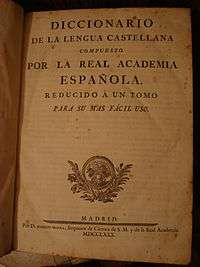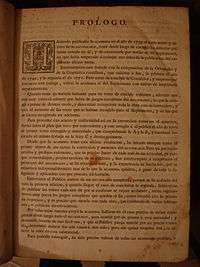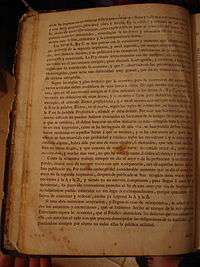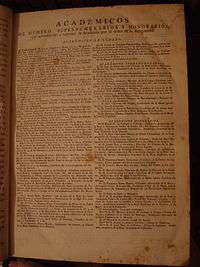Diccionario de la lengua española
The Diccionario de la lengua española (DLE; Spanish pronunciation: [diɡsjo'naɾjo de la 'leŋɡua espa'ɲola]; English: Dictionary of the Spanish language) is a dictionary of the Spanish language. Previously known as Diccionario de la Real Academia Española (English: Dictionary of the Royal Spanish Academy),[1] it is produced, edited, and published by the Real Academia Española (RAE; English: Royal Spanish Academy) with participation of the Asociación de Academias de la Lengua Española (ASALE; English: Association of Academies of the Spanish Language). It was first published in 1780, and subsequent editions have been published about once a decade. The twenty-third edition was published in 2014.

Origin and development
When the RAE was founded in 1713, one of its primary objectives was compiling a Castilian Spanish dictionary. Its first endeavor was the six-volume Diccionario de Autoridades (Dictionary of Authorities) from 1726 to 1739. Based on that work, an abridged version was published in 1780, the full title of which was Diccionario de la lengua castellana compuesto por la Real Academia Española, reducido á un tomo para su más fácil uso (Dictionary of the Castilian tongue composed by the Royal Spanish Academy, reduced to one volume for its easier use). According to its prologue, the dictionary was published for general public access during the long time between the publishing of the first and second editions of the exhaustive Diccionario de Autoridades, thus offering a cheaper reference book. By the time the second edition was published, it had become the principal dictionary, superseding its ancestor. The last edition of the Diccionario de Autoridades was published in 1793.
The fourth edition of the dictionary (1803) introduced the digraphs "ch" (che) and "ll" (elle) to the Spanish alphabet as separate, discrete letters. "Ch" was alphabetized between "c" and "d", while "ll" was alphabetized between "l" and "m". Also in 1803, the letter "x" was replaced with "j" when it had the same pronunciation as "j", and the circumflex accent (^) was eliminated. In 1994, it was decided at the 10th Congress of the Association of Academies of the Spanish Language to use the universal Latin alphabet, which does not include "ch" and "ll" as letters.[2]
The earliest editions were more extensive: they included Latin translations of the entry, in some cases gave usage examples (especially in popular phrases), and summarized the word's etymology; contemporary editions do so concisely. The earliest editions had "x" entries that no longer appear individually.
Historically, the decision to add, modify, or delete words from the dictionary has been made by the RAE, in consultation with other language authorities (especially in Latin America) when there was an uncertainty. This process continued between 1780 and 1992, but, since the 1992 edition, the RAE and the other discrete language academies forming the Association of Academies of the Spanish Language collaborate in producing the Dictionary of the Spanish Language.
Editions of the DLE




| Edition | Year |
|---|---|
| 1 | 1780 |
| 2 | 1783 |
| 3 | 1791 |
| 4 | 1803 |
| 5 | 1817 |
| 6 | 1822 |
| 7 | 1832 |
| 8 | 1837 |
| 9 | 1843 |
| 10 | 1852 |
| 11 | 1869 |
| 12 | 1884 |
| 13 | 1899 |
| 14 | 1914 |
| 15 | 1925 |
| 16 | 1936/1939 |
| 17 | 1947 |
| 18 | 1956 |
| 19 | 1970 |
| 20 | 1984 |
| 21 | 1992 |
| 22 | 2001 |
| 23 | 2014 |
Formats
Until the twenty-first edition, the DLE was published exclusively on paper. The 2001 edition was offered on CD-ROM and paper. The twenty-second edition was published in three formats, paper, CD-ROM, and on the Internet with free access. The freely-accessible online version as of October 2017 is the 23rd edition.[3]
Previous titles
From the first edition (1780) through the fourth edition (1803), the dictionary was known as the Diccionario de la lengua castellana compuesto por la Real Academia Española (Dictionary of the Castilian language composed by the Spanish Royal Academy). From the fifth edition (1817) through the fourteenth edition (1914), it was known as the Diccionario de la lengua castellana por la Real Academia Española (Dictionary of the Castilian language by the Spanish Royal Academy). Starting with the fifteenth edition (1925), it has been known as the Diccionario de la lengua española (Dictionary of the Spanish language).
Criticism
Inaccuracy
Some entries in the dictionary do not reflect current scientific understanding. An example is the definition of dinosaurio ("dinosaur"),[4] which refers only to sauropodomorphs.
Pejoratives
In 2006, The Spanish Federation of Jewish Communities complained that some of the dictionary's entries and definitions about Judaism were racist and offensive.[5] One definition of sinagoga (synagogue) is: "a meeting for illicit ends"; the nominal definition of 'synagogue' is given first, and the pejorative definition is so identified.
On November 2014 Gypsies in Spain informed against RAE at the European Court of Human Rights.[6] Yerba-buena, an association of Spanish Gitanos ("Gypsies" in English), complains that one definition of Gitano: "one who practices deceit" or "one who tricks", is offensive and could encourage racism;[7] nevertheless, the word gitano does actually mean "trickster" in Spanish, and other Spanish dictionaries include this definition.[8]
Although the RAE dismissed the complaints as political correctness, saying "we simply photograph the landscape; we do not create it",[5] in November 2014 it was announced they were going to modify the term,[9] and in October 2015 it was changed.[10]
RAE also defined "woman" as "weak sex".[11] On November 2017 the term was examined[12][13] and one month later it was changed.[14]
See also
- Descriptive linguistics
- Linguistic prescription
References
- (in Spanish) "Diccionario de la lengua española" Real Academia Española. Retrieved 10 November 2013.
- "X Congreso (Madrid, 1994)". Real Academia Española. Archived from the original on May 7, 2014. Retrieved October 25, 2017.
- "Diccionario de la lengua española". Real Academia Española. Archived from the original on October 25, 2017. Retrieved October 25, 2017.
- "Real Academia Española - Diccionario de la lengua española - Diccionario panhispánico de dudas - Aviso actualización enlaces". Buscon.rae.es. Retrieved 2013-08-18.
- "The Sunday Times". Timesonline.co.uk. Retrieved 2013-08-18.
- Europa Press (8 November 2014). "El colectivo gitano denunciará a la RAE ante el Tribunal de Derechos Humanos". El País (in Spanish). Madrid. Retrieved 9 July 2018.
- "Protestas contra la RAE por considerar racista la acepción de gitano". Radio Televisión Española (in Spanish). 7 November 2011. Retrieved 9 July 2018.
- EFE (23 August 2015). "La RAE mantendrá la polémica acepción de 'gitano' como 'trapacero'". Público (in Spanish). Display Connectors, S.L. Retrieved 9 July 2018.
- Europa Press (7 November 2014). "RAE no censurará la acepción polémica de 'gitano' pero buscará fórmulas para que se entienda su significado peyorativo". 20 Minutos (in Spanish). Retrieved 9 July 2018.
- Agencias (14 October 2015). "La RAE retoca la polémica acepción de 'gitano'". El Mundo (in Spanish). Madrid: Unidad Editorial. Retrieved 9 July 2018.
- Justo, David (20 December 2017). "La RAE sigue definiendo a la mujer como el 'sexo débil', pero admite que es despectivo". Cadena SER (in Spanish). Madrid. Retrieved 10 July 2018.
- Europa Press (29 November 2017). "La RAE actualizará en diciembre el uso de "sexo débil" como "despectivo" y "discriminatorio"". El Periódico de Catalunya (in Spanish). Grupo Zeta. Retrieved 10 July 2018.
- Europa Press (3 March 2017). "La RAE matizará la definición de 'sexo débil'". Huffington Post (in Spanish). España Prisa Noticias S.L.U. Retrieved 10 July 2018.
- Lázaro, Margarita (20 December 2017). "La RAE cambia el significado de 'sexo débil'". Huffington Post (in Spanish). España Prisa Noticias S.L.U. Retrieved 10 July 2018.
External links
- (in Spanish) Tesoro Lexicográfico de la lengua española, database with digital copies of all of the dictionaries edited and published by the RAE.
- (in Spanish) Real Academia Española webpage, with links to both the online version of the dictionary and the one of the Diccionario panhispánico de dudas.